Aspendos Travel Guide
Introduction
Aspendos Travel Guide – The Greco-Roman remains of Aspendos ancient city are situated in Pamphylia, approximately 40 km east of Antalya, on the Eurymedon river. The city was 16 km away from the Mediterranean coast. Founded in the 10th century BC, Aspendos was an important harbour city in the Roman era, and went through a centuries-long decline when the Empire broke up. Today, the Aspendos Ruins and Theatre are a tentative UNESCO World Heritage Site, thanks in large part to the impossibly-well-preserved theatre. Even if you feel like you’ve seen everything antiquity has to offer, but “you have not seen the theatre of Aspendos.” Standing 315 feet tall, it’s a monumental example of Roman architecture that’s still used for music and drama festivals today. While the theatre is the main attraction, you can also walk up to the acropolis, where you can find the remains of several buildings, including a monumental nymphaeum. Just north of the acropolis, you can see the remains of the city’s aqueduct, with an impressive mountain backdrop. The main reason for most of the tourists to visit Aspendos is its Roman theatre which is the best preserved structure of its kind in the world. The additional attraction of Aspendos lies in the possibility of participation in many artistic events organized in the theatre. However, Aspendos is more than just a theatre, there are also the ruins of many other structures, including a stadium, a basilica and an agora. Moreover, the local aqueduct is well-preserved. One of two starting points for the St. Paul’s walking trail starts in Aspendos, while the second one is situated in Perge.
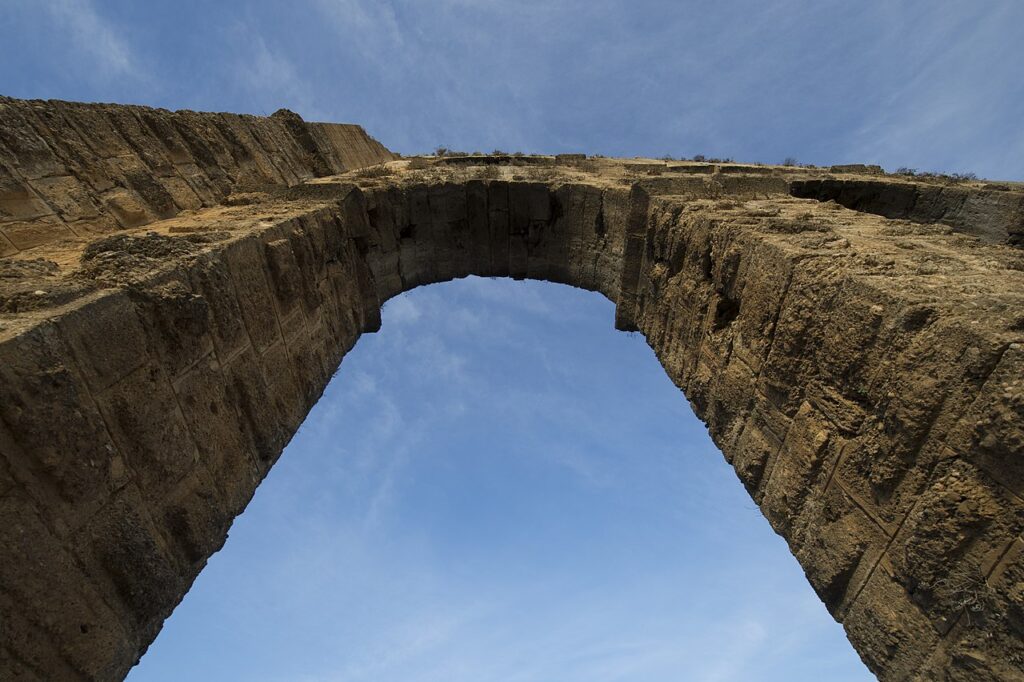
History
According to Greek tradition Aspendos was funded by the colonists from Argos who arrived here under the leadership of Mopsos around 1000 BC. Argos was a city located in the Peloponnese. Most probably the area of Aspendos had earlier been settled by the local inhabitants, but the city started to develop only after the arrival of the Greeks. Aspendos minted its own coins which were widely accepted in the ancient world, thus giving evidence to the huge importance of the city. In 5th century BC, Aspendos was the main city in Pamphylia and competed with Side that also minted its own silver coins. In the 5th and 4th centuries BC, according to the information provided by the coins, Aspendos was called Estwediya. This name may be derived from the name of king Asitawada who is mentioned on Hittite hieroglyphic inscriptions from Karatepe near Adana. The symbols of the city, visible on the coins, were two naked wrestlers.
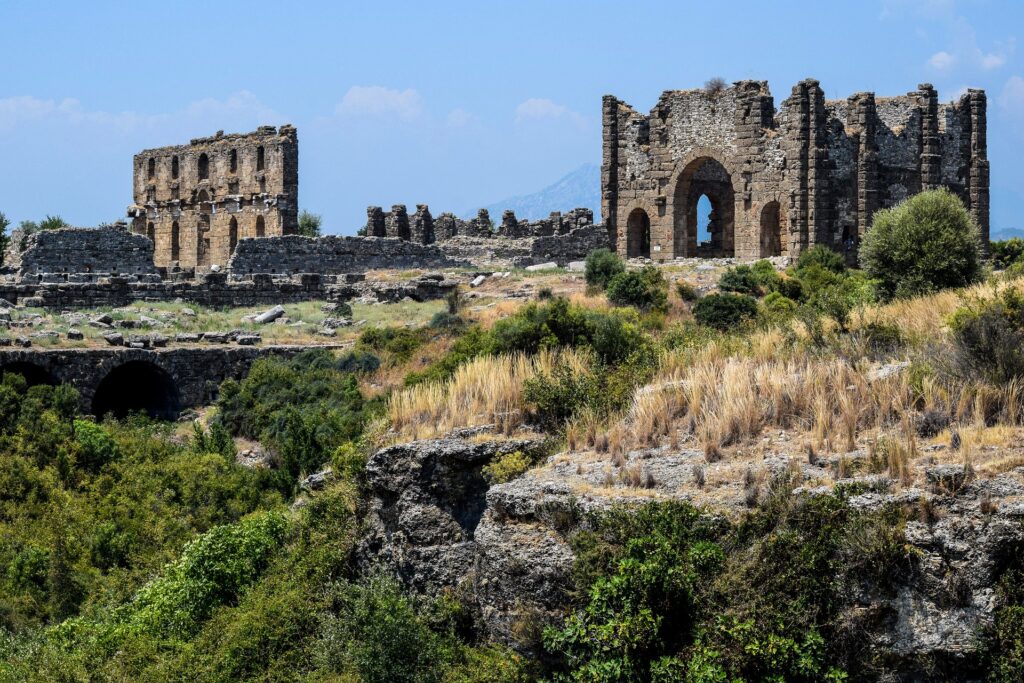
The significance of Aspendos in the Greek era did not come from its political influences, but from the well-developed economy which provided great wealth for the city. In these times the Eurymedon (present-day Köprüçay) river was navigable from the coast to Aspendos, i.e. the distance of 16 km. The city collected great incomes from the trade in salt, olive oil and wool. It was also renowned from horse breeding and its horses were highly valued in the whole Mediterranean region. The political history of Aspendos is similar to the history of the whole Pamphylia. Firstly, the city came under the Lydian rule and in 546 BC was conquered by Persians. However, the fact that it continued to mint its own coins meant that it had a relatively large degree of independence. In 467 BC an Athenian general and politician Kimon defeated a large Phoenician fleet, that formed the part of Persian military forces, near the mouth of the Eurymedon. Persian land forces were defeated by a stratagem, as the best Greek soldiers got dressed on the clothes that belonged to the Persian captives. When they arrived in the vicinity of the Persian camp, the Persians thought that they were released prisoners of war and started a large feast. During the celebrations the remaining part of Greek forces landed and destroyed them. Aspendos became a member of the Delian League, which was managed by Athens.
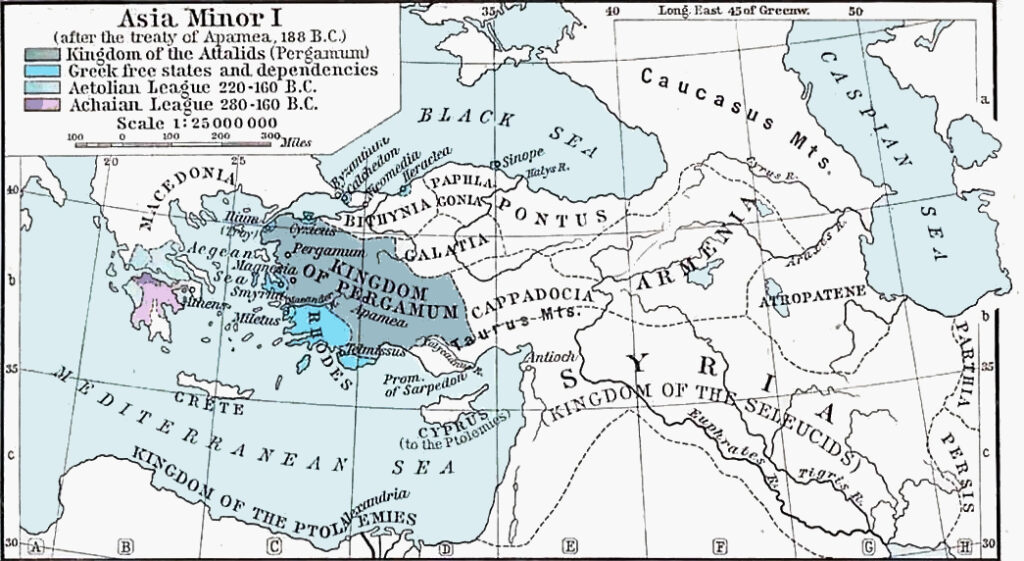
The Persians regained the control over Aspendos in 411 BC and transformed the city into a military base. In 389 BC one of the Athenian general tried to ‘liberate’ Aspendos, against the will of its inhabitants. They collected a large sum of money and gave it to the Greeks in return for their promise to withdraw their army. The general accepted this tribute, but his troops destroyed the fields surrounding Aspendos. In revenge the inhabitants of Aspendos murdered him. Aspendos remained under the Persian governance until 333 BC when Alexander the Great arrived to this part of Asia Minor, freshly victorious after the conquest of nearby Perge. Aspendos inhabitants offered the tribute in coins and horses to the Macedonian leader, equal to the one they had previously paid the Persians. Alexander the Great accepted these conditions and marched on to the east, to Side, leaving a small garrison in Aspendos, stationed in the lower city.
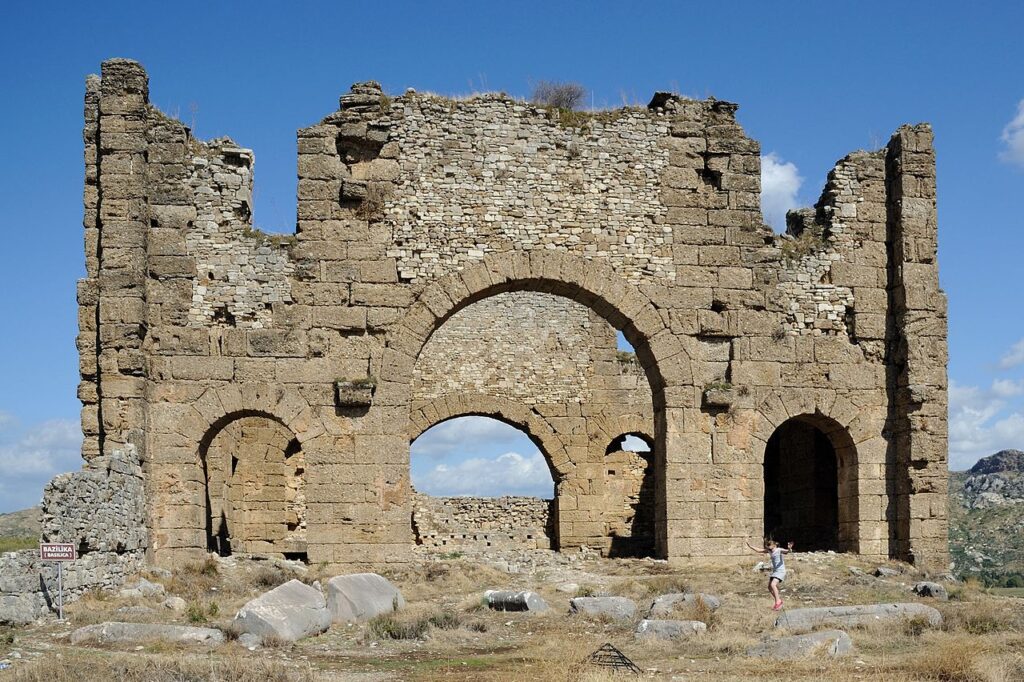
When the Macedonian army returned Alexander learned that Aspendos citizens had no intention of keeping the terms of their agreement and were preparing for defending their city from its acropolis. Alexander immediately changed the direction of his army route and when he got closer to the city, its inhabitants sent their emissaries again to renegotiate the agreement. This time they were forced to accept much harsher conditions: the Macedonian forces were to remain in the city permanently and the value of the annual tribute was raised to 100 gold talents and 4 thousand horses. In the Hellenistic period the importance of Aspendos grew and the city flourished. After the Battle of Magnesia in 190 BC, fought between Roman forces and the army of Antiochus III the Great of the Seleucid Empire, the Pamphylia area was officially incorporated into the kingdom of Pergamon. After the death of the last Pergamane king, Attalus III, his kingdom was bequeathed to Rome. The Romans rebuilt Aspendos and enriched it with many magnificent public buildings. In the period of its highest development the number of Aspendos inhabitants is estimated to reach 20 thousand.
The decline of the city started in the end of the Roman period and this process continued during the Byzantine times. The downfall of the city was speeded up by the Arab incursions in the 7th and the 11th century AD. In the 13th century the city was conquered by the Seljuks. In this period the Roman theatre in Aspendos was rebuilt by the orders of the sultan Ala ad-Din Kayqubad I. The theatre building was decorated with ceramic tiles and geometric paintings and transformed first into a sultan’s summer residence and then – into a caravanserai. In the 15th century AD Aspendos became a part of the Ottoman Empire.
Archaeological researches
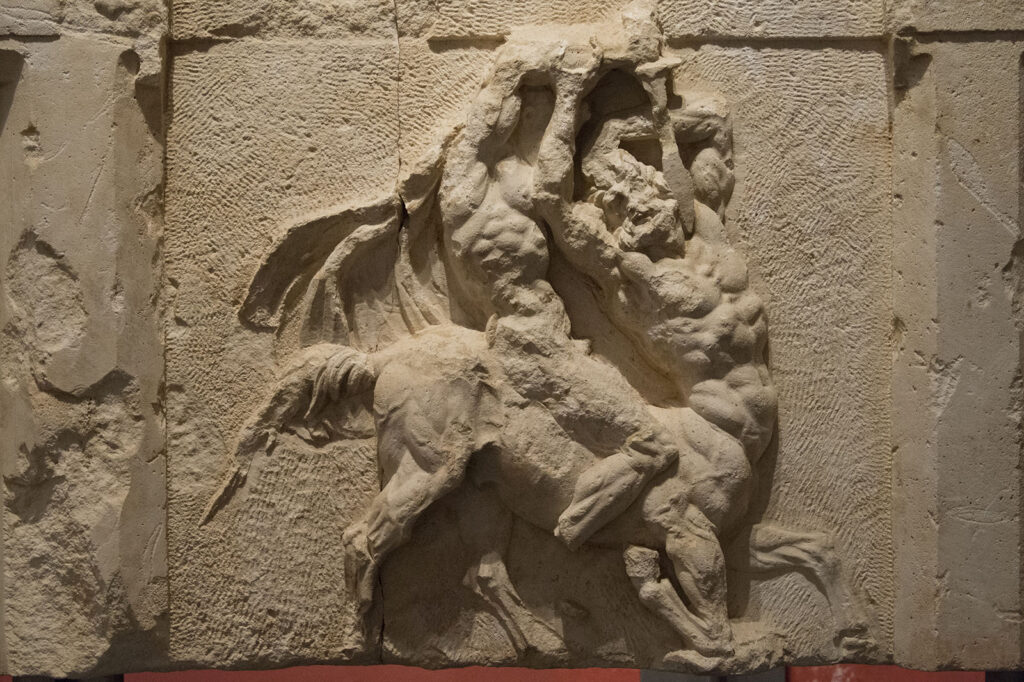
The latest round of archaeological excavations in Aspendos started in 2008 under the management of professor Veli Köse from Ankara‘s Hacettepe University. The goal of this research project is to study all the factors, natural and technological, that influenced the changes of the city and its surroundings, from the first settlements until the present times.The research started from the study of the city plan and its development. Currently, the scholars focus their efforts on the reconstruction of economic structure and political development of Aspendos. Their aim is to create a plan of urban area spatial development that will be used as a model for other Roman cities in the Mediterranean basin. The realization of the project encompasses geophysical research, the studies of ceramics and inscriptions as well as the reconstructions of historical buildings. Many finds from Aspendos excavations are on display in the Archaeological Museum in Antalya.
Main Buildings
Despite the long history of the city, all structures visible in its area are from the Roman period. So far the archaeologists have not identified any earlier structures from the Hellenistic times.
Theatre
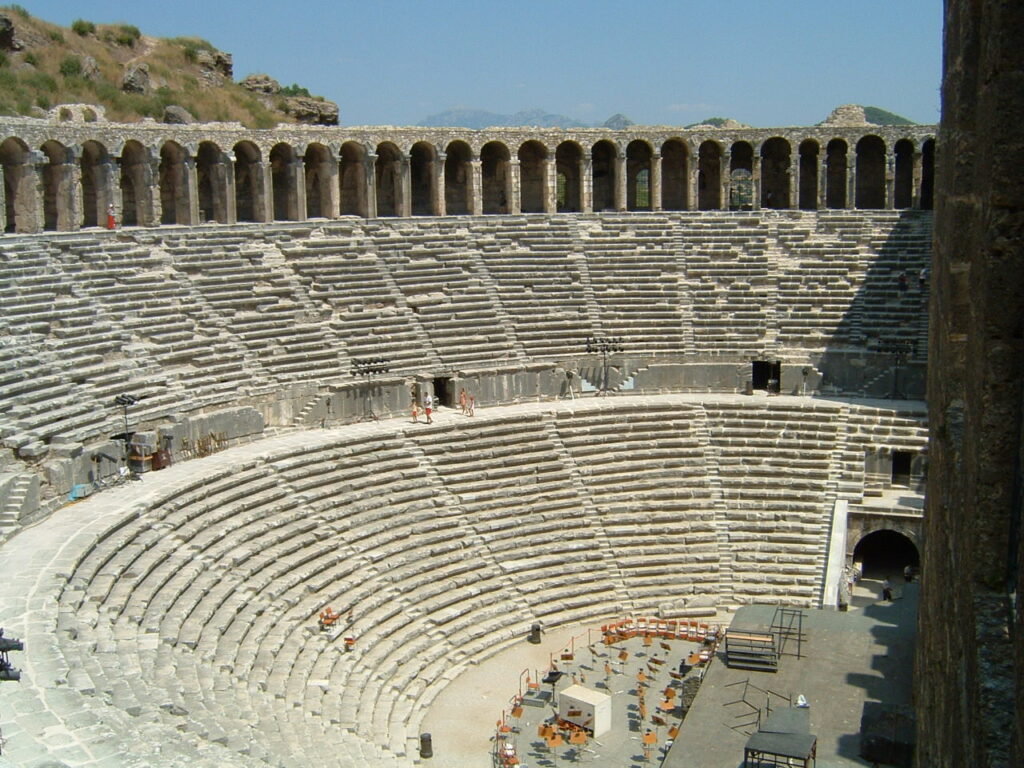
The theatre in Aspendos is considered to be the best preserved theatre of antiquity (Akurgal 2011). The Roman builders of this structure managed to express the state of ideal balance between the auditorium and the skene building and, what’s more, to the whole theatre matches perfectly into the landscape. According to a legend, the construction of this theatre resulted from the competition organised by the ruler of Aspendos. The aim of this competition was to build a structure that will contribute most to the city’s prosperity, and the winner was to be awarded the daughter of the ruler. Two competitors qualified to the final round. The first of them constructed the system of canals and aqueducts that supplied Aspendos with running water. The ruler was almost convinced to give him the hand of his daughter but decided to visit the theatre, built by the second competitor, for the last time. When he stood on the highest point of the theatre, suddenly a clear voice whispered directly into his ear: ‘Your daughter must be mine!’ When he looked around in surprise, he saw the builder of the theatre standing on the scene. The theatre’s acoustics impressed the ruler so much that he immediately decided in favour of its builder. The wedding took place, naturally, in the theatre itself. Despite the fact that the theatre was build in the Roman period, the building displays many features typical to Greek theatres. The auditorium rests in part against a hillside. Moreover, a horseshoe shape of the auditorium also is a Greek feature. On the other hand, according to the Roman standards, the theatre is cut off from the outside world by the skene building. Also the barrel-vaulted substructure is a typical Roman idea. The auditorium of the theatre has a diameter of 96 meters and is divided by a horizontal gangway (diazoma) into an upper and a lower part. It could accommodate up to 7 thousand spectators. An arcade above the auditorium supported by a colonnade used to provide the shade for the spectators when a linen canopy (i.e. velarium) was extended. 58 holes that were used for the montage of the masts are still visible there.

The skene building consists of a facade and a proscenium where the play was performed. The scaenae frons had five doorways giving entry to the proscenium. The largest gate in the middle was called porta regia and the four smaller ones – portae hospitales. The skene building used to be covered by an 8-meter wide wooden roof. The stage building (skene) was decorated from the inside by a two-tiered facade that still maintains its original height. From the outside the stage building has 17 windows and is visually divided into two levels. A buttress and a portal that resembles a tower were built in the Seljuq period when the building was used as a summer residence of sultans.
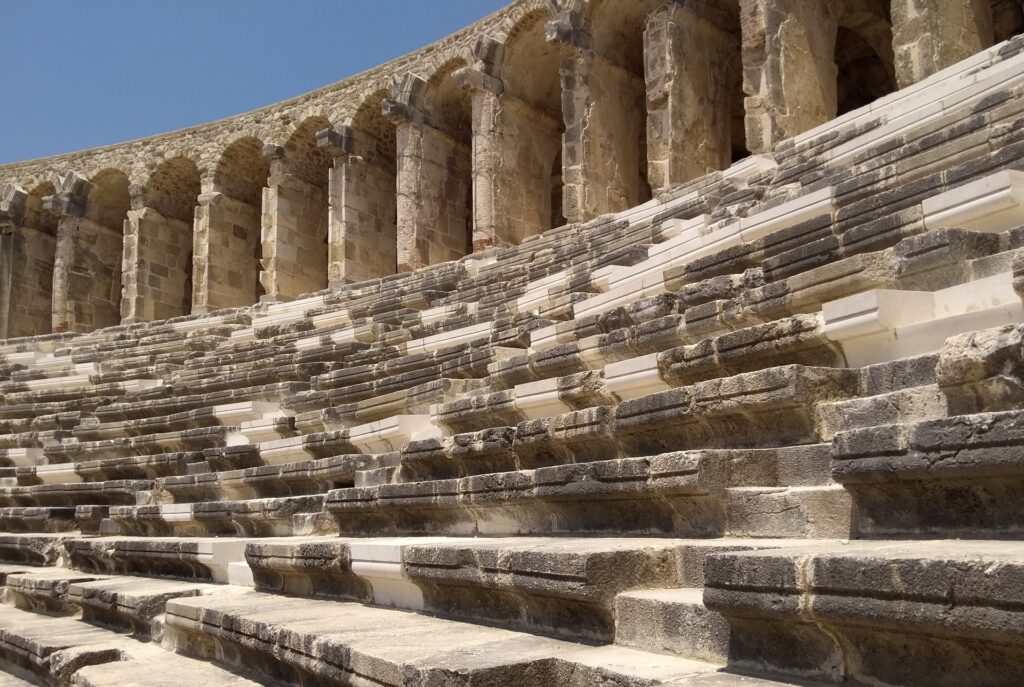
In the 30-ties of the 20th century Mustafa Kemal Atatürk visited Aspendos. After the inspection of the theatre the first President of the Turkish Republic stated that such a magnificent structure must not be wasted. He order its renovation that stirred many controversies among historians and architects. Since then the theatre is used as a venue for various cultural events, among them – International Ballet and Opera Festival (tr. Aspendos Uluslararası Opera ve Bale Festivali). The performances usually take place in late spring and early summer and the tickets are sold out many months before.
Aqueducts
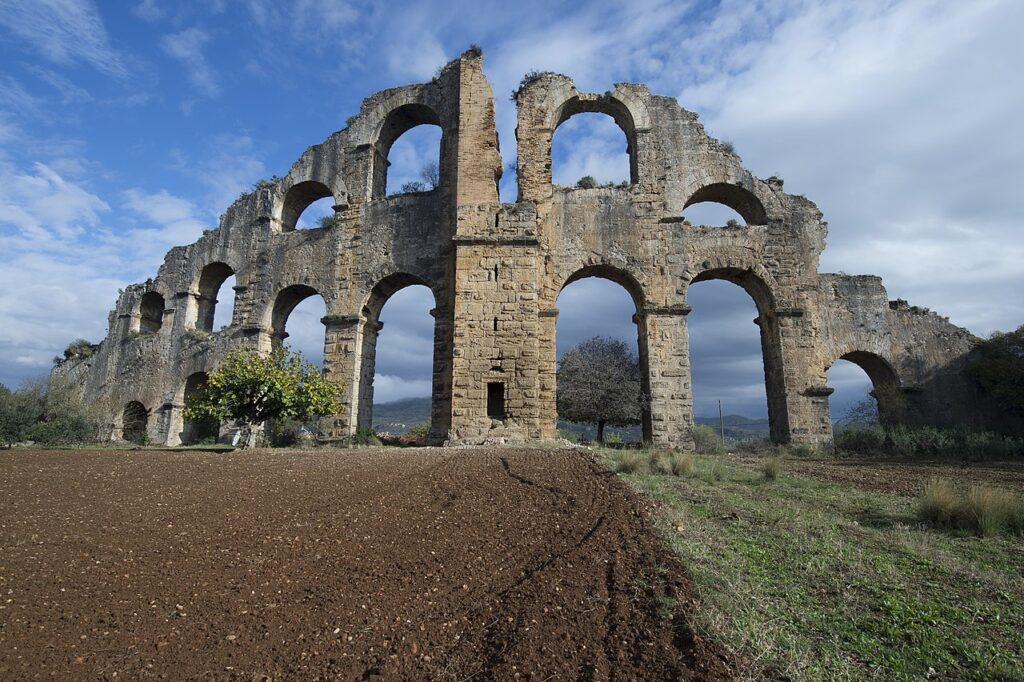
One of the best-preserved fragments of a Roman aqueduct in Turkey are situated in Aspendos. The water was supplied to the city from two sources in the mountains, approximately 17 km to the north of Aspendos. The water supply system consisted of a canal, bridges and tunnels. The last stretch of the system, 2-kilometers long, was a complicated system of reverse siphons and water towers that reached 30 meters of height. The leg between two towers led over the land and was placed on the system of some arcades in order to compensate for the uneven terrain. These arcades are 15 meters high and their upper part is 5.5 meters wide. For this reason some scholars claim that a road led there, above the ground, and it was used when the area was inundated.
Stadium
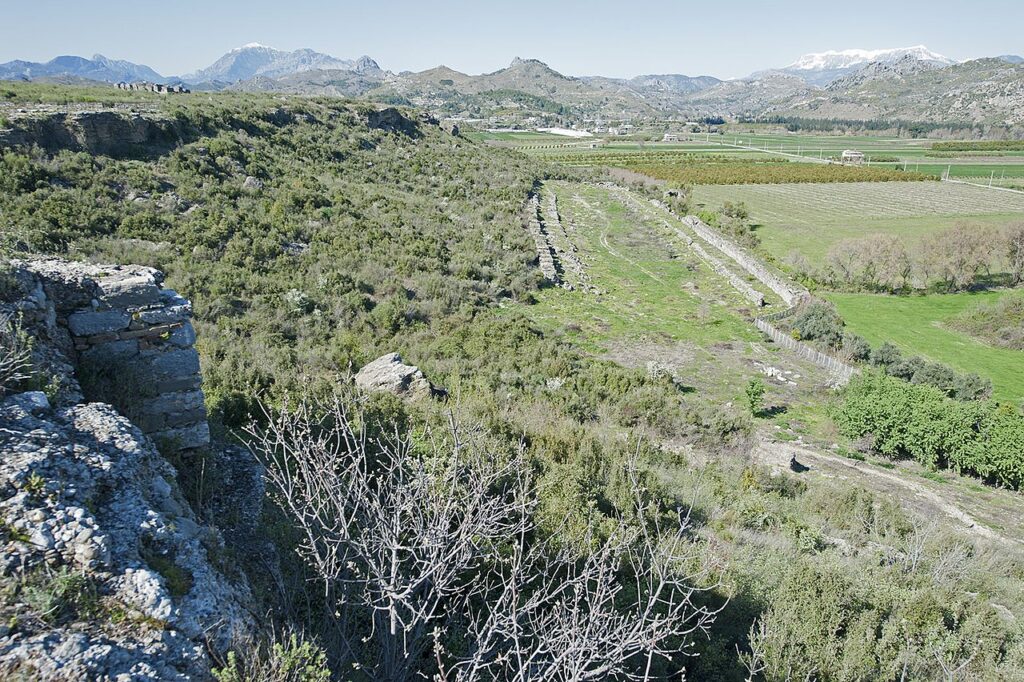
The remains of a stadium from the 2nd century AD are situated on the eastern slope of the acropolis hill in Aspendos. The stadium is U-shaped and its dimensions are 220 meters in length and 30 meters in width. Not much is preserved of this structure. Its north-eastern section is in the best condition and there one can see the fragments of seats and some arches that supported the whole construction. It is estimated that 8 thousand spectators could be seated in this stadium.
City gates
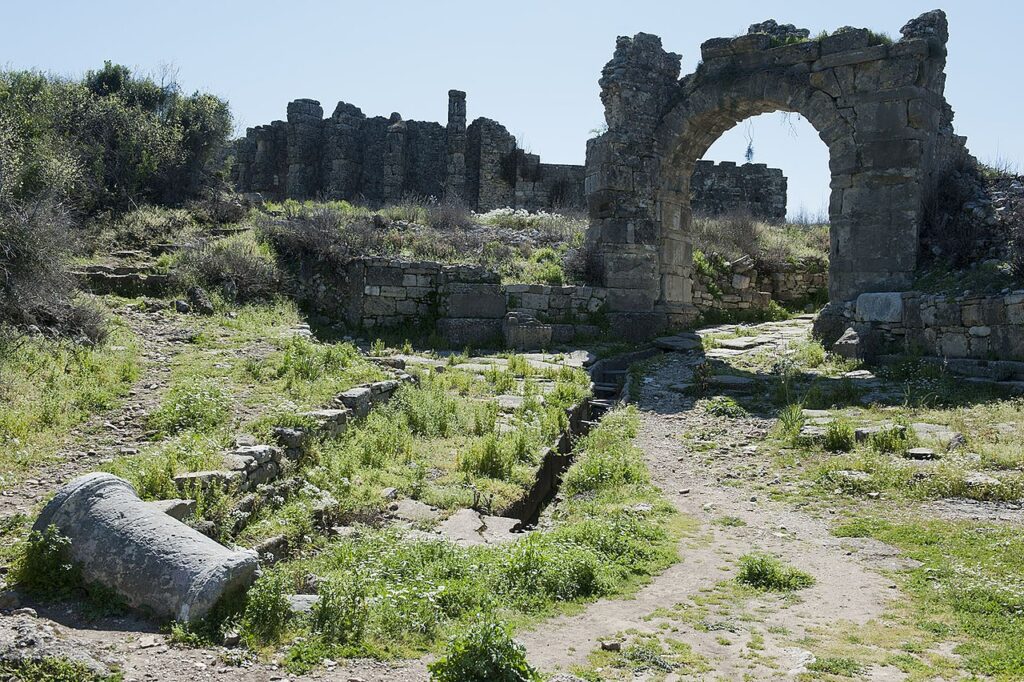
Three city gates have been preserved until the present times in the area of Aspendos acropolis, among them the southern gate is in the best condition. Additionally, an arch over the road that led from the eastern gate to the agora is still standing. Before this arch the road broadens thus creating a small square. Around it the bases where some statues used to stand are visible. The alley is intersected by the canal that transported the sewage from the acropolis.
Agora
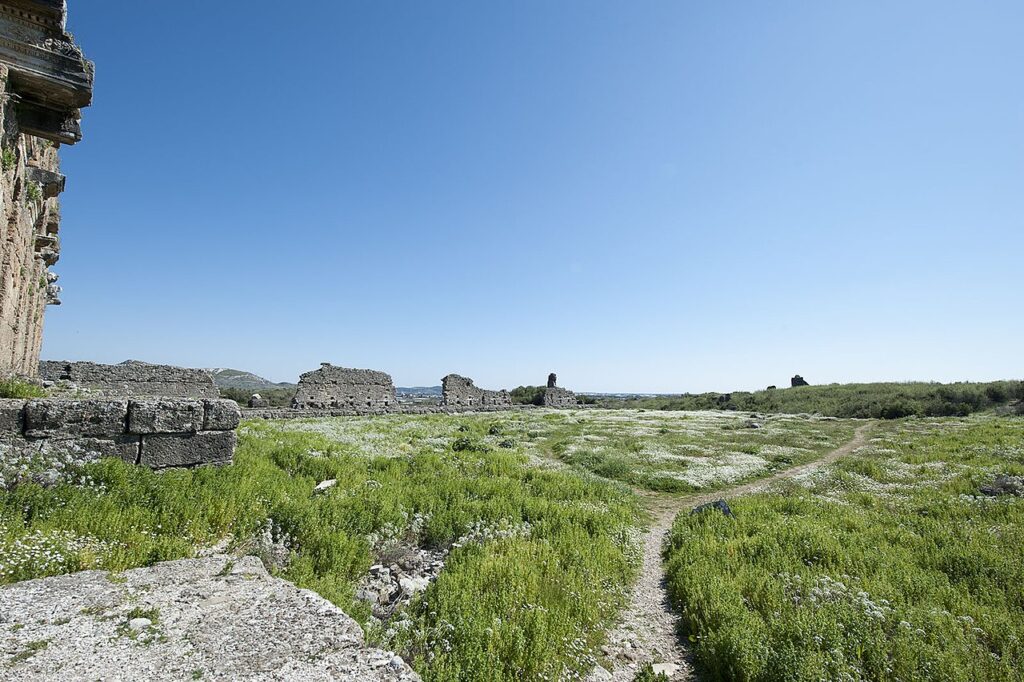
The main square of Aspendos had trading and political functions. It is situated in the middle of the acropolis and is surrounded by public city buildings, among them: a basilica, a nymphaeum, a bouleuterion, a market hall and an exedra. The shape of this agora is irregular and results from the topographical features of the hill.
Nymphaeum
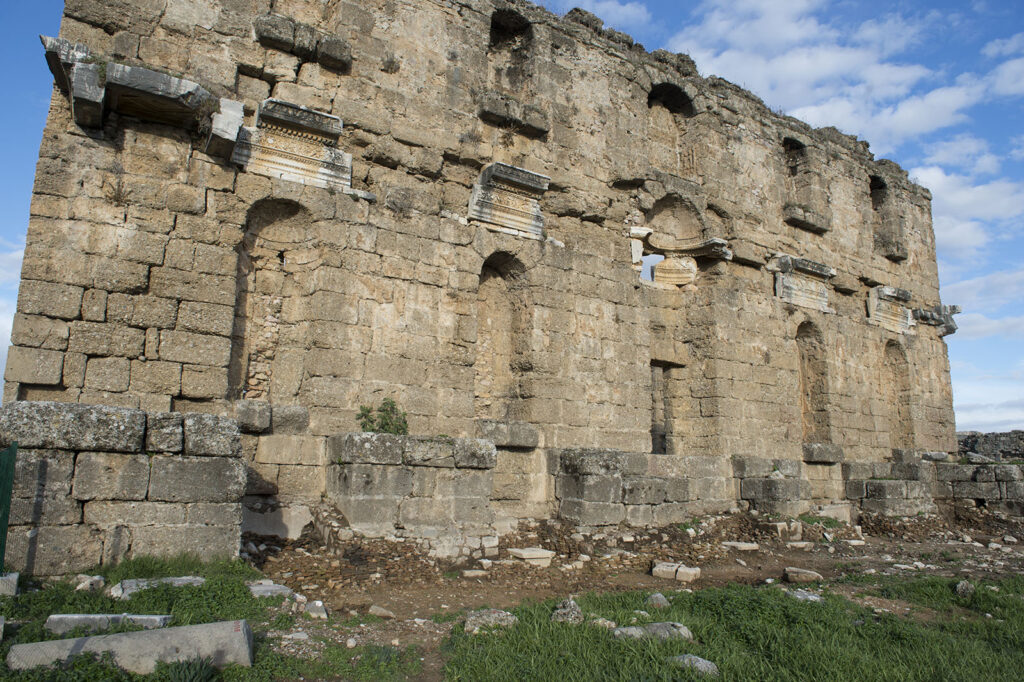
The only surviving part of a nymphaeum in Aspendos is its facade that resembles the nymphaeum in Side. The facade is two-tiered and each tier has five niches. The water, supplied by the piping system to the building, flowed from its middle niches. The height of the facade is 15 meters and its width – 32 meters. Above the lower row of niches some fragments of richly decorated beams have survived. In the past the façade was also decorated by an Ionic colonnade. The nymphaeum was built in the 2nd or the 3rd century AD.
Basilica
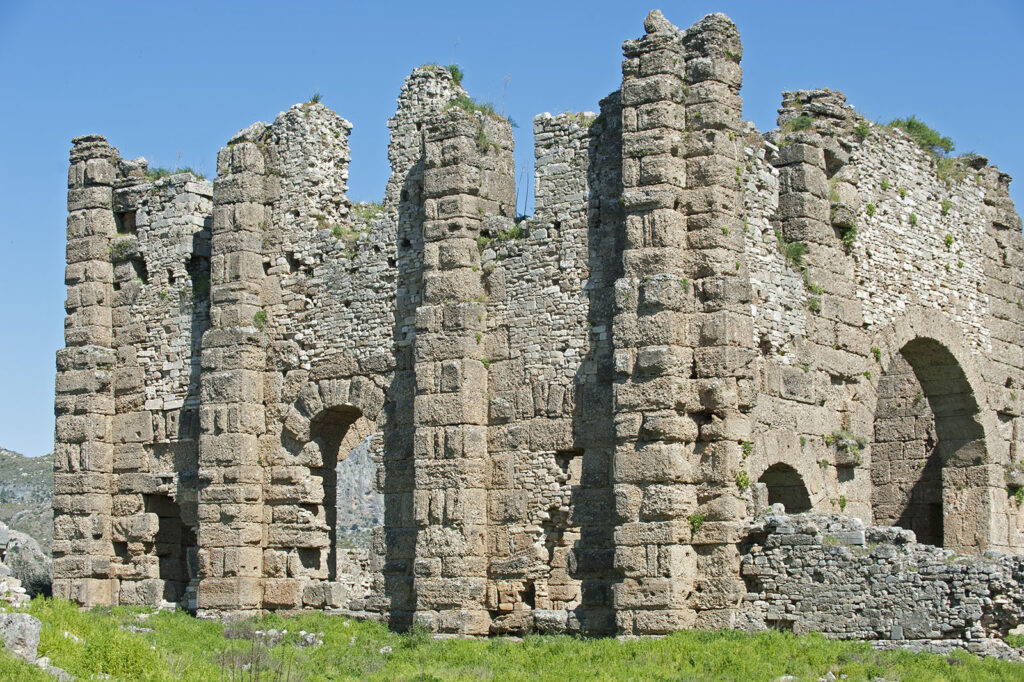
This basilica was one of the most important public city building. The eastern part of this building, which survived in excellent condition to the present day, was used as a political venue and a court. The size of this rectangular meeting hall is 20 by 25 meters. Two wide gateways, situated on the northern and southern walls, lead into the building. Inside three wall niches, where the statues were placed, are visible. The statues of Emperor Hadrian and a woman, found in this hall, are currently on display in the Archaeological Museum in Antalya. The western section of the basilica was used for commercial purposes. It was 105 meters long and divided into a central hall and two naves. Only foundations of this section are in evidence today.
Bouleuterion
Bouleuterion in Aspendos has a form of a roofed hall with rows of seats. There the city council met. The remains of this building are on the northern side of the nymphaeum. Currently only some fragment of its walls are visible along with the holes where the wooden roof was assembled.
Market hall
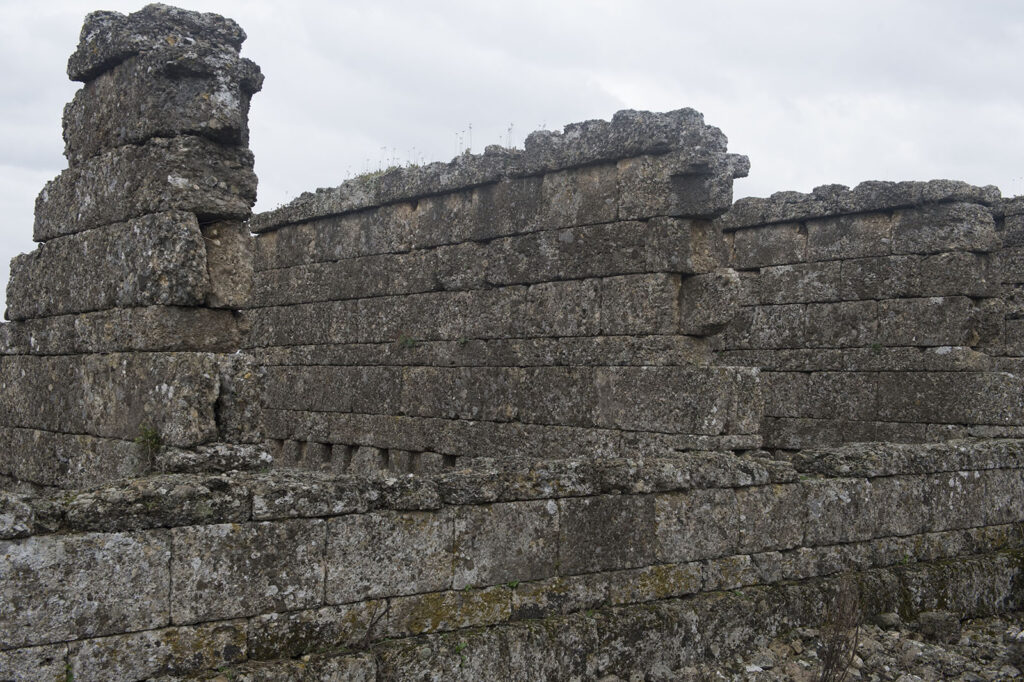
This 70 meters long building consisted of a row of smaller chambers where the shops were located. From the front side it was decorated by a stoa.
Exedra
This is a curvilinear open recess which in the past provided seats for the public. It was richly decorated with statues.
Temple
On the north-eastern side of the acropolis hill scant remains of a temple are visible. Its dimensions were 24 on 13 meters, and it represented the peripteros type i.e. it was surrounded around its outside by a colonnade (pteron) on all four sides of the cella. The Doric columns stood on a stylobate: 11 columns on its both longer sides and 6 columns on its both shorter sides. Additionally, some remains of a temenos wall are visible. The scholars have not been able to identify the deity that was worshipped in this temple.
Baths and gymnasium

Two vaulted structures that are visible along the road that leads to the theatre served, most probably, as baths and a gymnasium.
Necropolis
This cemetery from the classical period is located on the bottom of the acropolis, on its south-eastern side. Most of the graves were robbed in the antiquity. One of the most interesting archaeological finds from the necropolis area is a vessel that was used for mixing water and wine, i.e. a bell krater. This vessel from the 5th century BC, decorated with red figures, is exhibited in the Archaeological Museum in Antalya.










